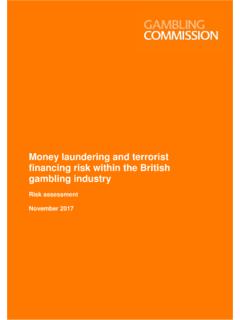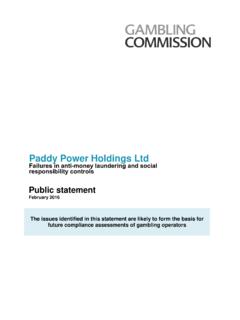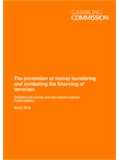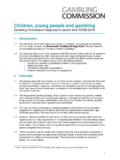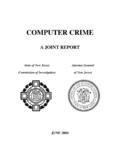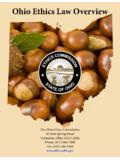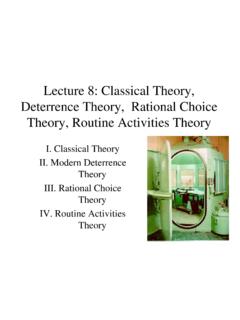Transcription of Gambling behaviour in Great Britain 2015 - …
1 Gambling behaviour in Great Britain in 2015 Evidence from England, Scotland and Wales Authors: Anne Conolly, Elizabeth Fuller, Hollie Jones, Natalie Maplethorpe, Annemijn Sondaal, Heather Wardle Date: August 2017 Prepared for: Gambling commission At NatCen Social Research we believe that social research has the power to make life better. By really understanding the complexity of people s lives and what they think about the issues that affect them, we give the public a powerful and influential role in shaping decisions and services that can make a difference to everyone. And as an independent, not for profit organisation we re able to put all our time and energy into delivering social research that works for society. NatCen Social Research 35 Northampton Square London EC1V 0AX T 020 7250 1866 A Company Limited by Guarantee Registered in England A Charity registered in England and Wales (1091768) and Scotland (SC038454) This project was carried out in compliance with ISO20252 Contents Executive summary.
2 1 1 Introduction .. 3 Background and aims .. 3 Overview of study design .. 3 Sources of data .. 3 Weighting .. 4 Caveats .. 4 Report and table conventions .. 5 2 Gambling participation .. 8 Introduction .. 8 Gambling participation by socio-demographic characteristics .. 8 Participation in Gambling activities in the past 12 months, by age and sex .. 8 Participation in Gambling activities in the past 12 months, by ethnic group .. 14 Participation in Gambling activities in the past 12 months, by highest educational 16 Participation in Gambling activities in the past 12 months, by economic activity .. 18 Participation in Gambling activities in the past 12 months, by NS-SEC of household reference person .. 20 Participation in Gambling activities in the past 12 months, by region .. 22 3 Prevalence and profile of at-risk gamblers .. 26 Introduction.
3 26 Prevalence of at-risk Gambling .. 27 Number of at-risk gamblers in the population .. 28 Prevalence of at-risk Gambling by activity .. 29 At-risk Gambling by number of activities .. 31 At-risk Gambling by socio-demographic characteristics .. 32 4 Prevalence and profile of problem gamblers .. 36 Introduction .. 36 Problem Gambling screens .. 36 The DSM-IV .. 36 The PGSI .. 37 Problem Gambling 37 Prevalence according to the DSM-IV .. 37 Prevalence according to the PGSI .. 39 Prevalence according to either screen .. 41 Number of problem gamblers in the population .. 43 Problem Gambling prevalence by activity .. 44 Problem Gambling prevalence by number of activities .. 46 Profile of problem gamblers .. 47 5 Trends in Gambling behaviour .. 51 Appendix A. Survey methodology review .. 54 Appendix B. Weighting .. 56 Appendix C. Scoring the problem Gambling screening instruments.
4 57 Appendix D. Survey questions .. 59 List of Tables Table 2:1 Participation in Gambling activities in the past 12 months, by sex .. 9 Table 2:2 Participation in Gambling activities in the past 12 months, by age and sex .. 11 Table 2:3 Participation in Gambling activities in the past 12 months, by ethnic group .. 15 Table 2:4 Participation in Gambling activities in the past 12 months, by highest educational qualification .. 17 Table 2:5 Participation in Gambling activities in the past 12 months, by economic activity .. 19 Table 2:6 Participation in Gambling activities in the past 12 months, by NS-SEC of household reference person .. 21 Table 2:7 Participation in Gambling activities in the past 12 months, by region .. 23 Table 3:1 PGSI Status, by age and sex .. 28 Table 3:2 Number of at-risk gamblers (according to PGSI)a .. 29 Table 3:3 At-risk Gambling prevalence, by activity.
5 30 Table 3:4 At-risk Gambling prevalence, by number of Gambling activities .. 31 Table 3:5 At-risk Gambling prevalence by socio-demographic characteristics .. 33 Table 4:1 Problem Gambling prevalence rates according to the DSM-IVa, by age and sexb .. 38 Table 4:2 Problem Gambling prevalence according to the PGSIa, by sex and ageb .. 40 Table 4:3 Problem Gambling prevalence according to either the DSM-IVa or PGSIb, by sex and agec .. 42 Table 4:4 Number of problem gamblers (according to DSM-IVa, PGSIb, or either) .. 44 Table 4:5 Problem Gambling prevalence (according to either DSM-IVa or PGSIb), by activityc .. 45 Table 4:6 Problem Gambling prevalence (according to either DSM-IVa or PGSIb), by number of Gambling activitiesc .. 46 Table 4:7 Problem Gambling prevalence (according to either DSM-IVa or PGSIb), by socio-demographic characteristicsc .. 48 Table A:1 Summary of survey features and their implications.
6 54 Table C:1 DSM-IV items .. 57 Table C:2 PGSI items .. 58 Table C:3 PGSI category .. 58 List of Figures Figure 3:1 At-risk Gambling prevalence (PGSI score of 1 to 7), by age and sex .. 27 Figure 4:1 Problem Gambling prevalence according to the DSM-IV among men, by age .. 39 Figure 4:2 Problem Gambling prevalence according to the PGSI among men, by 41 Figure 4:3 Problem Gambling prevalence among men according to either the DSM-IV or PGSI .. 43 Figure 4:4 Problem Gambling prevalence, by number of Gambling activities .. 47 Figure 5:1 Past year Gambling participation, by survey year .. 51 NatCen Social Research | Gambling behaviour in Great Britain in 2015 1 Executive summary This report provides information about Gambling behaviour in Great Britain using data combined from the Health Survey for England (HSE) 2015, and the Scottish Health Survey (SHeS) 2015 and the Wales Omnibus in 2015.
7 The main aims and objectives of this report were: to describe the prevalence of Gambling participation, at-risk Gambling and problem Gambling and; to explore characteristics associated with Gambling participation, at-risk Gambling , and problem Gambling . Participation in Gambling activities 63% of adults (16+) in Great Britain had gambled in the past year, with men (66%) being more likely than women (59%) to do so. The most popular Gambling activities were the National Lottery draws (46%), scratchcards (23%) and other lotteries (15%). Excluding those who only played the National Lottery draws, just under half of adults (45%) participated in other types of Gambling activity; 49% of men and 42% of women. For both men and women, overall participation was highest among the middle age groups and lowest among the youngest and oldest age groups. Excluding those who only played the National Lottery draw, Gambling participation was highest among younger adults.
8 Past year Gambling participation rates varied across regions, from 52% in London to 68% in Scotland. At-risk Gambling At-risk Gambling was measured using the Problem Gambling Severity Index (PGSI). This identifies people who are at risk of problems related to their Gambling behaviour but who are not classified as problem gamblers. Overall, of adults were classified as low risk gamblers (a PGSI score of 1 or 2) and a further as moderate risk gamblers (a PGSI score of 3 to 7), meaning that, overall, of adults had a PGSI score which categorised them as at-risk gamblers. Rates of low risk and moderate risk Gambling were higher among men than women and were higher among younger age groups. Problem Gambling Problem Gambling is Gambling to a degree that compromises, disrupts or damages family, personal or recreational pursuits. Estimates of problem Gambling are 2 NatCen Social Research | Gambling behaviour in Great Britain in 2015 provided according to two different measurement instruments, the Diagnostic and Statistical Manual of Mental Disorders IV (DSM-IV) and the PGSI.
9 According to the DSM-IV, problem Gambling prevalence among adults living in private households was Men were more likely than women to be classified as a problem gambler according to the DSM-IV ( and respectively). According to the PGSI, problem Gambling prevalence was , with men again being more likely than women to be classified as a problem gambler ( and respectively). Problem Gambling prevalence measured by either the DSM-IV or the PGSI was , with men being more likely than women to be classified as problem gamblers ( and respectively). The highest rates of problem Gambling were among those who had participated in spread betting ( ), betting via a betting exchange ( ), playing poker in pubs or clubs ( ), betting offline on events other than sports or horse or dog racing ( ) and playing machines in bookmakers ( ). Problem Gambling was more prevalent among people who had participated in a number of Gambling activities in the past year (prevalence was for those who participated in seven or more activities compared to of those who had taken part in just one Gambling activity in the last year).
10 NatCen Social Research | Gambling behaviour in Great Britain in 2015 3 1 Introduction Background and aims Great Britain has one of the most accessible Gambling markets in the world. Opportunities to gamble exist on most high streets and, with the spread of the internet, in virtually every home. The majority of British people have gambled at some point, be it buying a ticket for the National Lottery or having a flutter on a popular horse race like the Grand National. Most of those who gamble have no issues with keeping their Gambling engagement within sensible and affordable limits. However, for some, Gambling can be problematic, affecting their ability to live and work. People with Gambling problems often experience a range of negative effects, including health issues, relationship breakdown, and difficulties with debt. In more severe cases Gambling problems can lead to crime, thoughts of suicide or suicide itself1.



